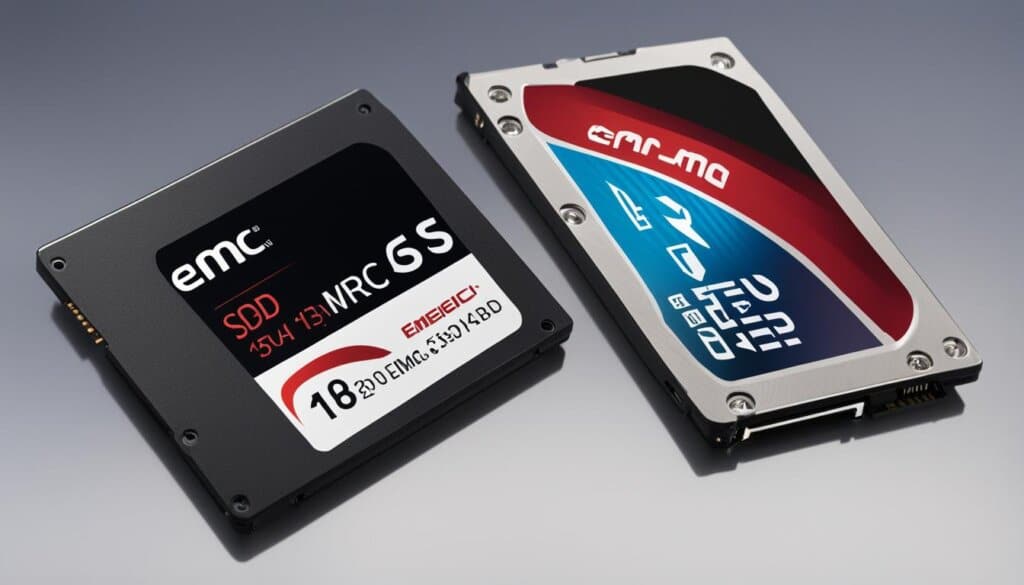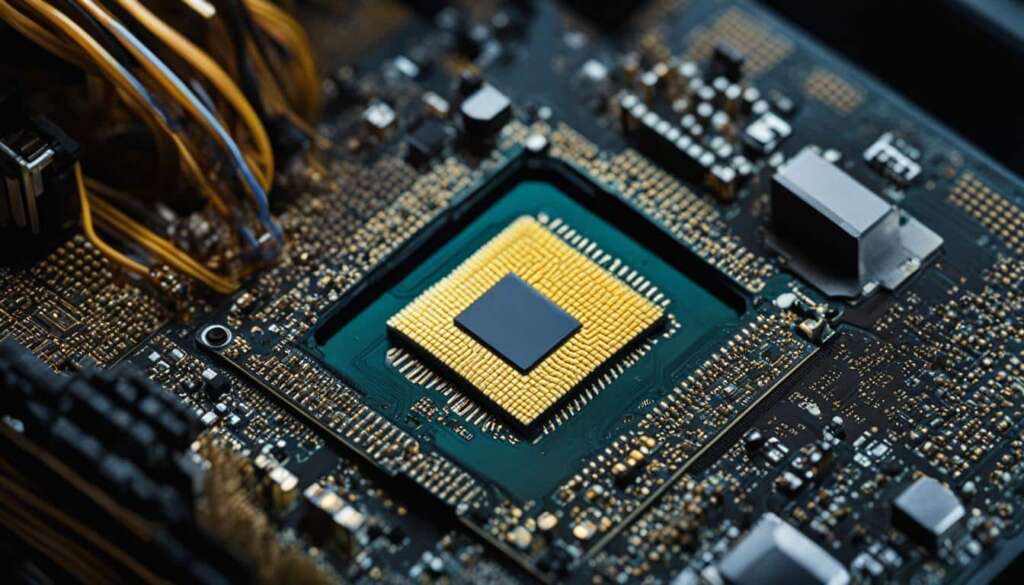Table of Contents
An embedded MultiMediaCard (eMMC) is a small storage device that combines NAND flash memory and a storage controller on a single integrated circuit (IC). It was developed in 2006 by JEDEC and the MultiMediaCard Association. eMMC is commonly used in portable devices like cell phones and tablets, as well as IoT sensors. It serves as the primary storage for these devices and can be supplemented with removable storage options like microSD cards. The latest eMMC specification allows for transfer rates up to 400 MBps, comparable to a SATA-connected solid-state drive. Use cases for eMMC include mobile devices, IoT sensors, and onboard entertainment or navigation systems in automobiles.
Embedded MultiMediaCard (eMMC) storage is an integral part of many portable devices such as cell phones, tablets, and IoT sensors. It combines NAND flash memory and a storage controller into a compact and efficient package. Developed in 2006 by JEDEC and the MultiMediaCard Association, eMMC is widely used due to its affordability, reliability, and compatibility with various devices and applications.
What is eMMC?
eMMC, short for embedded MultiMediaCard, is a type of storage found in devices like cell phones, tablets, and low-cost laptops. It combines NAND flash memory and a storage controller into a single chip that is permanently soldered onto the device’s motherboard. Similar to SD cards, eMMC utilizes non-volatile NAND flash technology, which does not require power to retain data. It is smaller in size, more cost-effective, and consumes less power compared to solid-state drives (SSDs). However, eMMC storage is typically slower than SSDs due to its limited number of NAND gates and is best suited for smaller file sizes.
eMMC Storage Specifications
| Aspect | eMMC | SSD |
|---|---|---|
| Capacity Range | 32GB – 128GB | 128GB – Several Terabytes |
| Data Transfer Speeds | Up to 400MB/s | Up to 7.0GB/s (NVMe) |
| Size | Smaller | Larger |
| Cost | More Affordable | Higher Cost |
| Power Consumption | Lower Power Consumption | Relatively Higher Power Consumption |
“eMMC storage combines NAND flash memory and a storage controller into a small chip, making it a cost-effective and power-efficient choice for devices like smartphones and tablets.”
Despite its slower speeds, eMMC storage excels at everyday tasks like web browsing, email, and video streaming. Its compact size and affordability make it an ideal choice for low-cost laptops and entry-level devices. However, for more demanding applications that require larger storage capacities and faster transfer speeds, solid-state drives (SSDs) are the preferred option. SSDs offer greater performance and the ability to upgrade or replace the storage in the future.
eMMC vs. SSDs: What You Should Know
When comparing eMMC storage to solid-state drives (SSDs), there are several factors to consider.
eMMC storage capacities typically range from 32GB to 128GB, while SSDs offer larger capacities starting from 128GB up to several terabytes. This difference in storage capacity is crucial for individuals or organizations requiring extensive data storage and frequent file transfers.
While eMMC can achieve transfer speeds up to 400MB/s, SSDs with newer protocols like NVMe can reach speeds up to 7.0GB/s. The faster transfer speeds of SSDs enable quick data access and enhanced performance, making them ideal for resource-intensive tasks such as gaming and content creation.
Additionally, eMMC chips utilize a single NAND gate, while SSDs can employ up to 20 NAND gates. This difference in NAND gates directly impacts data transfer rates, with SSDs outperforming eMMC storage in terms of speed and efficiency.
Despite its limitations, eMMC storage is well-suited for everyday tasks like video streaming and email. Its affordability and reliability make it a popular choice for budget-friendly devices. On the other hand, SSDs are the preferred option for users demanding high performance and larger storage capacities.
To summarize:
eMMC Storage:
- Typically offers storage capacities ranging from 32GB to 128GB
- Transfer speeds up to 400MB/s
- Utilizes a single NAND gate
- Best suited for everyday tasks like video streaming and email
SSDs:
- Offers larger storage capacities starting from 128GB up to several terabytes
- Transfer speeds up to 7.0GB/s with newer protocols like NVMe
- Can employ up to 20 NAND gates
- Ideal for resource-intensive applications like gaming and content creation
Ultimately, the choice between eMMC and SSDs depends on specific needs and use cases. While eMMC storage provides a more budget-friendly option with sufficient performance for basic tasks, SSDs offer superior speed and storage capabilities for demanding applications. Consider factors such as affordability, performance requirements, and future expandability when making a decision between eMMC and SSDs.

Pros and Cons of eMMC Storage
eMMC storage offers both advantages and disadvantages for users. Let’s explore the pros and cons of this storage technology:
Pros of eMMC Storage
- Affordability: One of the major advantages of eMMC storage is its affordability. Devices equipped with eMMC storage are often more budget-friendly compared to those with solid-state drives (SSDs), making them a cost-effective choice for users.
- Battery Life: eMMC chips consume less power, resulting in improved battery life for portable devices. This makes eMMC storage an excellent option for users who prioritize long-lasting battery performance.
When it comes to affordability and battery life, eMMC storage shines. However, it is important to consider the potential downsides as well:
Cons of eMMC Storage
- Limited Storage Capacities: eMMC storage chips have limited storage capacities compared to SSDs. While SSDs offer larger storage options ranging from 128GB to several terabytes, eMMC storage usually ranges from 32GB to 128GB. This limitation may pose a challenge for users with extensive storage needs.
- Slower Transfer Speeds for Larger Files: Another drawback of eMMC storage is its slower transfer speeds for larger files. While eMMC can achieve transfer rates of up to 400MB/s, SSDs with newer protocols like NVMe can reach speeds of up to 7.0GB/s. Users handling large files or running resource-intensive applications may experience slower performance with eMMC storage.
- Non-Upgradable Storage: Unlike SSDs, eMMC storage is not easily replaceable or upgradable. As eMMC chips are permanently soldered onto the device’s motherboard, users cannot swap them out for larger or faster storage options. This lack of flexibility can be a disadvantage for users who anticipate future storage expansion needs.
Despite these limitations, eMMC storage is still suitable for basic tasks such as web browsing and video streaming. It provides an affordable storage solution with improved battery life for everyday use. However, users requiring faster speeds and larger storage capacities may need to consider alternative options like SSDs.
Now that we have explored the pros and cons of eMMC storage, let’s take a closer look at the future of this technology and how it compares to emerging alternatives.
Future of eMMC: UFS as a Replacement
As technology continues to advance, the future of eMMC storage lies in the emergence of Universal Flash Storage (UFS). UFS aims to replace both eMMC and SD flash memory cards, offering faster transfer speeds and higher storage capacities.
Samsung, a renowned tech giant, has already introduced UFS memory for portable devices and SD cards based on UFS technology. With its improved performance, UFS presents a compelling alternative to eMMC storage.
“UFS offers faster transfer speeds and higher storage capacities compared to eMMC.”
However, eMMC is still widely used in mobile devices and low-cost laptops due to its affordability and compatibility. Despite the potential of UFS, eMMC is expected to continue its presence in entry-level and budget-friendly devices for the foreseeable future.
The table below provides a comparison of eMMC and UFS storage:
| Storage Standard | Transfer Speeds | Storage Capacities |
|---|---|---|
| eMMC | Up to 400MB/s | 32GB – 128GB |
| UFS | Significantly faster than eMMC | Varies, but higher capacities available |
The above table clearly demonstrates the superior transfer speeds and larger storage capacities of UFS compared to eMMC.
While UFS shows promise as the storage technology of the future, it will take time for it to become mainstream and replace eMMC entirely. For now, eMMC remains the go-to storage solution for entry-level and cost-effective devices.
Choosing Between eMMC and SSDs
When it comes to deciding between eMMC and SSDs, the choice ultimately depends on the specific needs and use case of the individual or organization. If affordability is a priority and the device will mainly be used for basic tasks like web browsing and email, eMMC storage may be a suitable option.
On the other hand, if performance and the ability to handle resource-intensive applications are important factors, SSDs are the superior choice. SSDs offer faster speeds, larger storage capacities, and the option to upgrade or replace the storage in the future.
When making a decision between eMMC and SSDs, it is crucial to consider factors such as budget, intended use, and the need for future expandability. By carefully evaluating these aspects, individuals and organizations can make the right storage choice that balances performance and affordability.
FAQ
What is eMMC?
eMMC stands for embedded MultiMediaCard. It is a type of storage found in devices like cell phones, tablets, and low-cost laptops. eMMC combines NAND flash memory and a storage controller into a single chip that is permanently soldered onto the device’s motherboard.
How does eMMC compare to SSDs?
When comparing eMMC storage to solid-state drives (SSDs), there are several factors to consider. eMMC storage capacities typically range from 32GB to 128GB, while SSDs offer larger capacities starting from 128GB up to several terabytes. While eMMC can achieve transfer speeds up to 400 MB/s, SSDs with newer protocols like NVMe can reach speeds up to 7.0 GB/s.
What are the advantages and disadvantages of eMMC storage?
eMMC storage has several advantages, including affordability and lower power consumption. However, it has limited storage capacities, slower transfer speeds for larger files, and is not easily replaceable or upgradable like SSDs.
What is the future of eMMC?
The future of eMMC is the Universal Flash Storage (UFS), an emerging storage standard that aims to replace both eMMC and SD flash memory cards. UFS offers faster transfer speeds and higher storage capacities.
How do I choose between eMMC and SSDs?
Choosing between eMMC and SSDs depends on the specific needs and use case. If affordability and basic tasks are a priority, eMMC storage may be sufficient. However, if performance and the ability to handle resource-intensive applications are important, SSDs are the better choice.













